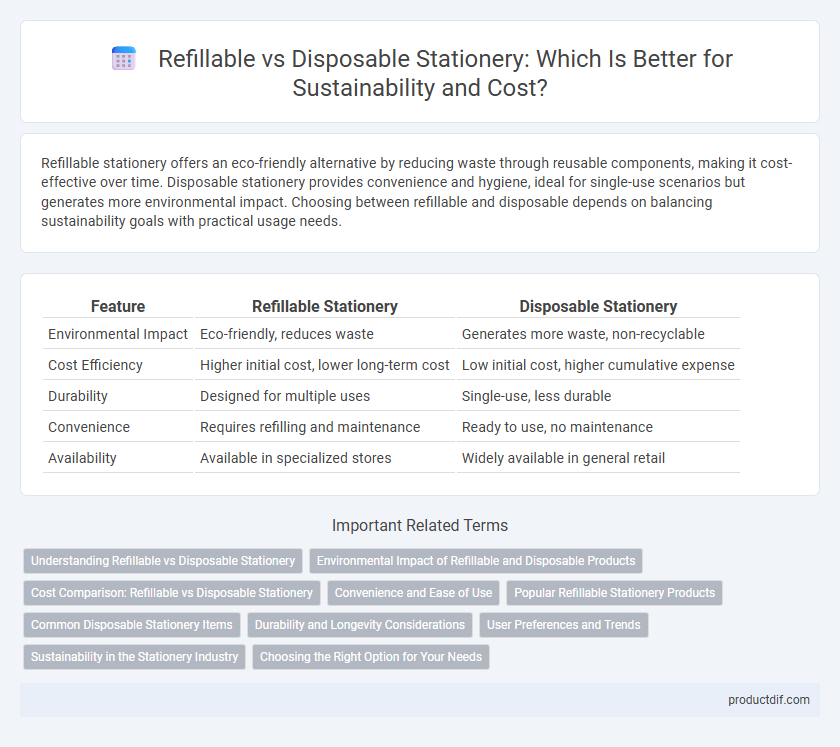Refillable stationery offers an eco-friendly alternative by reducing waste through reusable components, making it cost-effective over time. Disposable stationery provides convenience and hygiene, ideal for single-use scenarios but generates more environmental impact. Choosing between refillable and disposable depends on balancing sustainability goals with practical usage needs.
Table of Comparison
| Feature | Refillable Stationery | Disposable Stationery |
|---|---|---|
| Environmental Impact | Eco-friendly, reduces waste | Generates more waste, non-recyclable |
| Cost Efficiency | Higher initial cost, lower long-term cost | Low initial cost, higher cumulative expense |
| Durability | Designed for multiple uses | Single-use, less durable |
| Convenience | Requires refilling and maintenance | Ready to use, no maintenance |
| Availability | Available in specialized stores | Widely available in general retail |
Understanding Refillable vs Disposable Stationery
Refillable stationery products, such as pens and markers, offer sustainable alternatives by allowing users to replace ink or lead, reducing waste and long-term costs. Disposable stationery is designed for single use, often resulting in higher environmental impact due to frequent disposal and manufacturing of replacements. Understanding the lifecycle and environmental footprint of refillable versus disposable stationery helps consumers make eco-conscious and economical choices.
Environmental Impact of Refillable and Disposable Products
Refillable stationery products significantly reduce environmental impact by minimizing plastic waste and lowering resource consumption through repeated use, whereas disposable items contribute to landfill accumulation and increased carbon emissions from frequent manufacturing. Choosing refillable pens, markers, and correction tapes supports sustainability by extending product lifecycles and decreasing the demand for raw materials. This shift not only curbs pollution but also promotes a circular economy in the stationery industry.
Cost Comparison: Refillable vs Disposable Stationery
Refillable stationery, such as pens and markers, offers a lower cost per use compared to disposable options due to replaceable ink cartridges or refills, reducing the need for frequent repurchases. While disposable stationery has a lower upfront price, the cumulative expenses over time increase significantly as entire units must be replaced after use. Investing in refillable products not only minimizes long-term costs but also supports sustainable practices by reducing waste.
Convenience and Ease of Use
Refillable stationery offers greater convenience by reducing the need for frequent replacements, making it ideal for long-term use. Disposable products provide ease of use with no maintenance required, perfect for quick tasks and travel. Choosing between them depends on balancing user preferences for sustainability versus instant usability.
Popular Refillable Stationery Products
Popular refillable stationery products include fountain pens, mechanical pencils, and traditional staplers, which offer long-term cost savings and environmental benefits by reducing waste. Refillable ink cartridges and pencil leads provide consistent performance and allow users to customize their writing experience with various ink colors and lead types. These eco-friendly options combine durability with versatility, making them a preferred choice among students, professionals, and stationery enthusiasts.
Common Disposable Stationery Items
Common disposable stationery items include single-use pens, correction tapes, and glue sticks, favored for their convenience and affordability. These products often lead to increased waste due to their non-refillable design, impacting environmental sustainability. Choosing refillable alternatives like fountain pens or refillable markers reduces plastic waste and promotes long-term cost savings.
Durability and Longevity Considerations
Refillable stationery products typically offer greater durability and longer lifespan compared to disposable options, as their design allows for repeated use and easy replacement of ink or lead. These sustainable choices reduce waste and provide cost-efficiency over time by minimizing the need for frequent repurchasing. Disposable stationery, while convenient for short-term use, often compromises on durability and contributes to higher environmental impact due to limited lifespan and single-use materials.
User Preferences and Trends
User preferences in stationery increasingly favor refillable pens due to sustainability concerns and cost-effectiveness over time. Market trends reveal a growing demand for eco-friendly products, with refillable options gaining popularity among environmentally conscious consumers. Disposable pens maintain appeal for convenience but face declining usage as awareness of plastic waste rises.
Sustainability in the Stationery Industry
Refillable stationery products significantly reduce environmental impact by minimizing plastic waste and resource consumption compared to disposable alternatives. The sustainability benefits of refillable pens, notebooks, and other materials align with growing consumer demand for eco-friendly office supplies. Incorporating refillable options in the stationery industry supports circular economy principles, decreasing landfill contributions and promoting long-term ecological balance.
Choosing the Right Option for Your Needs
Refillable stationery products, such as pens and markers, offer long-term cost savings and environmental benefits by reducing waste and the need for frequent replacements. Disposable options, while convenient and often cheaper upfront, contribute to greater plastic waste and may require more frequent purchases, impacting sustainability goals. Assessing daily usage patterns, budget constraints, and environmental priorities is essential to choosing between refillable and disposable stationery.
Refillable vs Disposable Infographic

 productdif.com
productdif.com